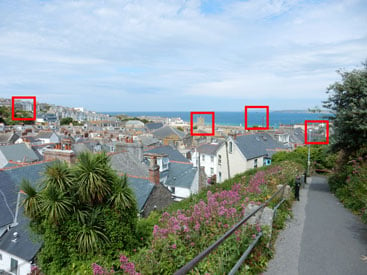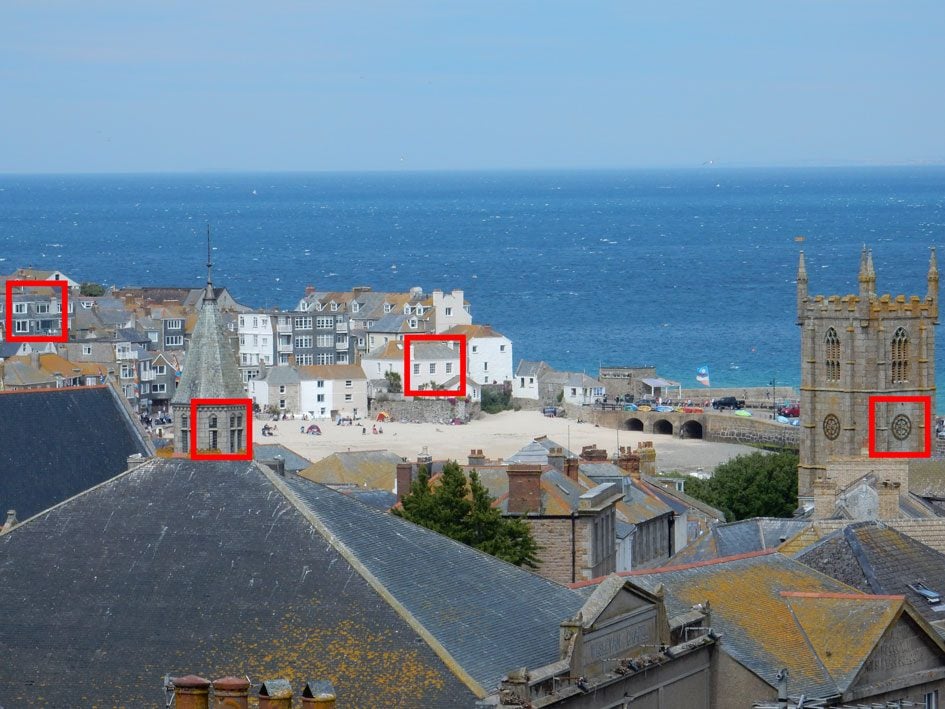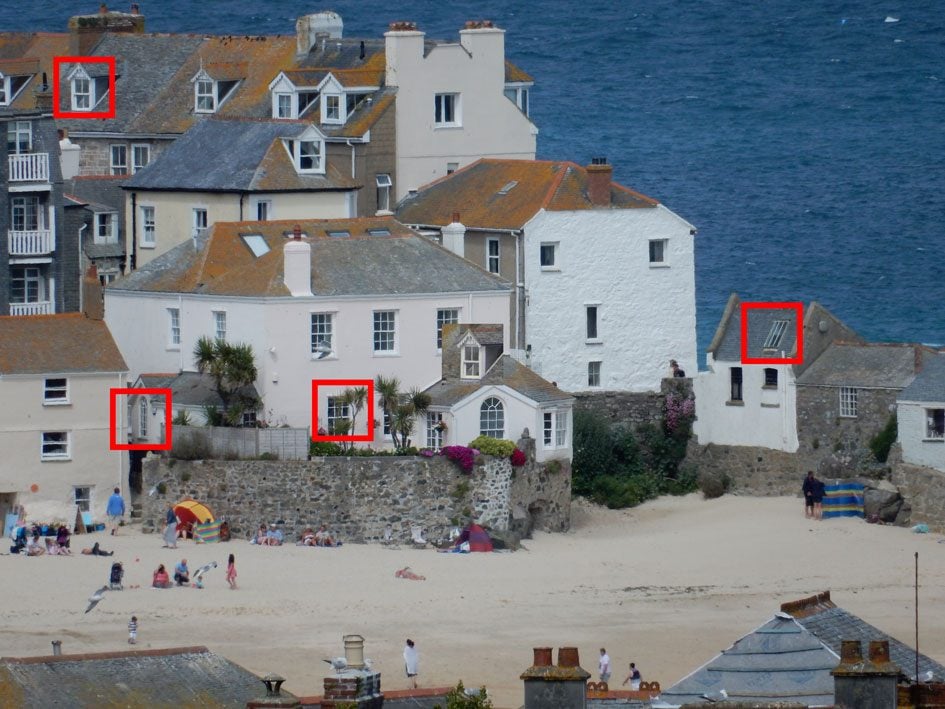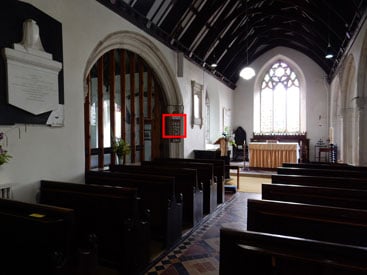Nikon COOLPIX S9900 review
-
-
Written by Ken McMahon
Quality
Nikon COOLPIX S9900 vs Sony HX90V vs Panasonic Lumix TZ70 / ZS50 quality results
To compare real-life performance, I shot this scene with the Nikon COOLPIX S9900, the Sony Cyber-shot HX90V and the Panasonic Lumix TZ70 / ZS50 within a few moments of each other, using their best quality JPEG settings and at their base sensitivity settings. All three cameras were set to their maximum wide angle setting. At 25mm equivalent, the COOLPIX S9900 has a slightly narrower field of view than the 24mm Sony HX90V and Lumix TZ70 / ZS50. In practice, however, the difference is quite small and it proved impractical to zoom the HX90V and TZ70 / ZS50 in by such a small amount.

For this test the cameras were mounted on a tripod and image stabilisation was disabled except on the HX90V where it can’t be turned off. The ISO sensitivity was manually set to the lowest available setting and for the wide angle shots all three models were set to f4 in aperture priority mode. All other settings were left on the defaults.
The first crop from the Nikon COOLPIX S9900 is a little blurred, it’s taken from close to the left edge of the frame so you wouldn’t expect it to be as sharp as those from the centre, but you might prefer it a little sharper than it is. Things are looking better in the second crop from closer to the centre of the frame though. Despite metering a similar exposure, the COOLPIX S9900 crops are a little brighter than those form the Sony HX90V and Lumix TZ70 / ZS50, and they’re also a lot bluer. Despite that, you can see that there’s more detail with sharper edges in the second crop. Though it’s not that crisply defined, you can make out the lighthouse in the third crop, despite a bit of atmospheric haze (the lighthouse is more than four miles away!) but it’s not as clear as in the Lumix TZ70 / ZS50 crop.
Finally, the fourth crop from close to the right edge of the frame looks very similar to the first one from the other side. It’s just a little too blurry to be able to make out the finer detail in the trees to the right of the roof tiles beyond.
Overall this isn’t a bad result result for the COOLPIX S9900 and I’d certainly be happy with full sized prints made from shots taken at this sensitivity setting. However, both the Sony HX90V and the Lumix TZ70 / ZS50 have managed a little better, capturing more detail with sharper edges across the frame.
The 16 Megapixel sensor of the COOLPIX S9900 produces a larger crop area with slightly smaller detail than the 18 Megapixel HX90V, but I think the HX90V’s lens is mostly responsible for its sharper, more detailed crops. The size difference is more pronounced on the crops from the 12 Megapixel Lumix TZ70 / ZS50 but you can see more detail in the Lumix crops – and there’s also less evidence of noise. Keep reading to see how they compare when zoomed-into about 180mm.

Above left: COOLPIX S9900 at 4.5mm (25mm equivalent) f4, 125 ISO. Above center: Sony H90V at 4.1mm (24mm equivalent) f4, 80 ISO. Above right: Lumix TZ70 / ZS50 at 4.3mm (24mm equivalent) f4, 80 ISO.

Above left: COOLPIX S9900 at 4.5mm (25mm equivalent) f4, 125 ISO. Above center: Sony H90V at 4.1mm (24mm equivalent) f4, 80 ISO. Above right: Lumix TZ70 / ZS50 at 4.3mm (24mm equivalent) f4, 80 ISO.

Above left: COOLPIX S9900 at 4.5mm (25mm equivalent) f4, 125 ISO. Above center: Sony H90V at 4.1mm (24mm equivalent) f4, 80 ISO. Above right: Lumix TZ70 / ZS50 at 4.3mm (24mm equivalent) f4, 80 ISO.

Above left: COOLPIX S9900 at 4.5mm (25mm equivalent) f4, 125 ISO. Above center: Sony H90V at 4.1mm (24mm equivalent) f4, 80 ISO. Above right: Lumix TZ70 / ZS50 at 4.3mm (24mm equivalent) f4, 80 ISO.
Nikon COOLPIX S9900 vs Sony HX90V vs Panasonic Lumix TZ70 / ZS50 quality at approx 180mm

The second set of crops was taken with the lens zoomed in to around 180mm equivalent which provides a field of view that you can see in the main image. In this set of crops there’s less variation in quality from the edge to the centre of the frame and generally the COOLPIX S9900 crops look sharper. At this zoom setting there’s actually little to tell between the Sony HX90V and COOLPIX S9900 crops which supports the conclusion that it’s the HX90V’s superior lens, rather than the sensor that gives it the quality edge at the wider end of the zoom range. In fact I’d go as far as to say the COOLPIX S9900 does better at this focal length than the Sony HX90V becuase it’s crops are a little less noisy. The Lumix TZ70 / ZS50’s even less noisy crops come out on top though, vindicating Panasonic’s decision to pull back from ever increasing Megapixel counts on its compact sensors. Keep reading to see how they compare at their maximum focal lengths.

Above left: COOLPIX S9900 at 30mm (175mm equivalent) f6.3, 125 ISO. Above center: Sony H90V at 34mm (188mm equivalent) f6.3, 80 ISO. Above right: Lumix TZ70 / ZS50 at 33mm (184mm equivalent) f6.3, 80 ISO.

Above left: COOLPIX S9900 at 30mm (175mm equivalent) f6.3, 125 ISO. Above center: Sony H90V at 34mm (188mm equivalent) f6.3, 80 ISO. Above right: Lumix TZ70 / ZS50 at 33mm (184mm equivalent) f6.3, 80 ISO.

Above left: COOLPIX S9900 at 30mm (175mm equivalent) f6.3, 125 ISO. Above center: Sony H90V at 34mm (188mm equivalent) f6.3, 80 ISO. Above right: Lumix TZ70 / ZS50 at 33mm (184mm equivalent) f6.3, 80 ISO.

Above left: COOLPIX S9900 at 30mm (175mm equivalent) f6.3, 125 ISO. Above center: Sony H90V at 34mm (188mm equivalent) f6.3, 80 ISO. Above right: Lumix TZ70 / ZS50 at 33mm (184mm equivalent) f6.3, 80 ISO.
Nikon COOLPIX S9900 vs Sony HX90V vs Panasonic Lumix TZ70 / ZS50 quality at approx 750mm
The final set of crops was shot at the maximum zoom range of all three modes – 750mm on the COOLPIX S9900 and 720mm equivalent on the Sony HX90V and Lumix TZ70 / ZS50. As always, the crops are taken from the areas marked by the red squares below, and at this focal length, there’s some degradation due to heat rising.

Interestingly, here again a quality gap opens up between the COOLPIX S9900 and the Sony HX90V with the HX90V producing sharper crops with better detail right across the frame. Once again though, it’s the Lumix TZ70 / ZS50 that wins the day. Although its 12 Megapixel sensor produces smaller detail, there’s more of it and it’s sharper than the results from either the Sony HX90V or the COOLPIX S9900. But how do they compare at higher sensitivities? Find out in my Nikon COOLPIX S9900 noise results, or skip to my Nikon COOLPIX S9900 sample images, or head straight to my verdict.

Above left: COOLPIX S9900 at 123mm (720mm equivalent) f6.4, 125 ISO. Above center: Sony H90V at 135mm (750mm equivalent) f6.4, 80 ISO. Above right: Lumix TZ70 / ZS50 at 129mm (720mm equivalent) f6.4, 80 ISO.

Above left: COOLPIX S9900 at 123mm (720mm equivalent) f6.4, 125 ISO. Above center: Sony H90V at 135mm (750mm equivalent) f6.4, 80 ISO. Above right: Lumix TZ70 / ZS50 at 129mm (720mm equivalent) f6.4, 80 ISO.

Above left: COOLPIX S9900 at 123mm (720mm equivalent) f6.4, 125 ISO. Above center: Sony H90V at 135mm (750mm equivalent) f6.4, 80 ISO. Above right: Lumix TZ70 / ZS50 at 129mm (720mm equivalent) f6.4, 80 ISO.

Above left: COOLPIX S9900 at 123mm (720mm equivalent) f6.4, 125 ISO. Above center: Sony H90V at 135mm (750mm equivalent) f6.4, 80 ISO. Above right: Lumix TZ70 / ZS50 at 129mm (720mm equivalent) f6.4, 80 ISO.
Nikon COOLPIX S9900 vs Sony HX90V vs Lumix TZ70 / ZS50 noise results
To compare noise levels under real-life conditions, I shot this scene with the Nikon COOLPIX S9900, the Sony HX90V and the Panasonic Lumix TZ70 / ZS50 within a few moments of each other at each of their ISO settings. All three cameras were set to their best quality JPEG modes and mounted on a tripod. Stabilisation was disabled except on the HX90V where it can’t be turned off. Auto DRO was disabled on the HX90V, but otherwise the cameras were left on their default settings.

All three cameras were set to their maximum wide angle setting. At 25mm equivalent, the COOLPIX S9900 has a slightly narrower field of view than the 24mm Sony HX90V and Lumix TZ70 / ZS50. In practice, however, the difference is quite small and it proved impractical to zoom the HX90V and TZ70 / ZS50 in by such a small amount.
All three cameras were set to f4 in aperture priority mode. At its base 125 ISO sensitivity the COOLPIX S9900 metered 1/6 and at 80 ISO the HX90V and TZ70 / ZS50 metered an exposure of 0.4s. I took crops from each ISO setting from each camera and have presented them below at 100%; the cropped area is marked by a red square on the image above.
There are some just perceptible noise textures in the first crop from the COOLPIX S9900 at its base 125 ISO sensitivity setting. You have to look very closely to notice it, and I think that’s because Nikon’s noise suppression is doing a good job of covering it up. It has a bit more of a job on its hands at 200 ISO which looks a tiny bit noisier, but not much. However, as a result of the noise supression, even at this relatively low sensitivity setting, the detail is smoothed, it’s particularly noticable in the text on the label at the top of the Hymn board.
By 400 ISO, the COOLPIX S9900 crop is still looking remarkably clean, the noise suppression is doing a really good job, but the detail looks quite soft as a result. At 800 ISO, though, it’s too much of a struggle and noise textures are becoming more prominent. It’s still a pretty good result for a compact sensor at 800 ISO though, and would make an ok print at modest sizes.
At 1600 ISO the COOLPIX S9900 crop looks clumpy and a lot of the medium sized detail has been lost, at this setting things look pretty ugly at 100 percent viewing sizes, but you’ll still get away with it at smaller sizes. Like the Lumix TZ70 / ZS50, the COOLPIX S9900’s 6400 ISO setting is great to have for low light emergencies, but probaly best avoided otherwise.
Nikon’s noise suppression is very effective and as a result the finer detail is smoothed, so there’s less speckling than in the HX90V 80 ISO crop, but less detail too. It’s the same story all the way up the ISO range, with the COOLPIX S9900 applying more aggressive noise reduction resulting in less grainy, but less detailed crops. At less then 100 percent viewing sizes, there’s not much difference, but I prefer the Sony approach which accepts a little bit of graininess in return for more image detail.
The 12 Megapixel sensor in the Lumix TZ70 / ZS50 produces a larger crop area with smaller detail and the crops are significantly less noisy than those from either the HX90V or the COOLPIX S9900. Where the COOLPIX S9900 starts off with a relatively noisy image and processes it, the Lumix TZ70 / ZS50 has less noise in the first place. Despite that there’s a little more speckling in the TZ70 / ZS50 crops at the higher sensitivities, but there’s none of the smoothing and consequently a lot more detail than in the COOLPIX S9900 crops.
Finally, just to note that, though it lacks a 6400 ISO setting, the Sony HX90V’s Multi Frame Noise Reduction feature can shoot noise-reduced composites all the way up to 12800 ISO

Above left: COOLPIX S9900 80 ISO not available. Above center: Sony HX90V at 80 ISO. Above right: Lumix TZ70 / ZS50 at 80 ISO.

Above left: COOLPIX S9900 at 125 ISO. Above center: Sony HX90V at 100 ISO. Above right: Lumix TZ70 / ZS50 at 100 ISO.

Above left: COOLPIX S9900 at 200 ISO. Above center: Sony HX90V at 200 ISO. Above right: Lumix TZ70 / ZS50 at 200 ISO.

Above left: COOLPIX S9900 at 400 ISO. Above center: Sony HX90V at 400 ISO. Above right: Lumix TZ70 / ZS50 at 400 ISO.

Above left: COOLPIX S9900 at 800 ISO. Above center: Sony HX90V at 800 ISO. Above right: Lumix TZ70 / ZS50 at 800 ISO.

Above left: COOLPIX S9900 at 1600 ISO. Above center: Sony HX90V at 1600 ISO. Above right: Lumix TZ70 / ZS50 at 1600 ISO.

Above left: COOLPIX S9900 at 3200 ISO. Above center: Sony HX90V at 3200 ISO. Above right: Lumix TZ70 / ZS50 at 3200 ISO.

Above left: COOLPIX S9900 at 6400 ISO. Above center: Sony HX90V 6400 ISO not available. Above right: Lumix TZ70 / ZS50 at 6400 ISO.




